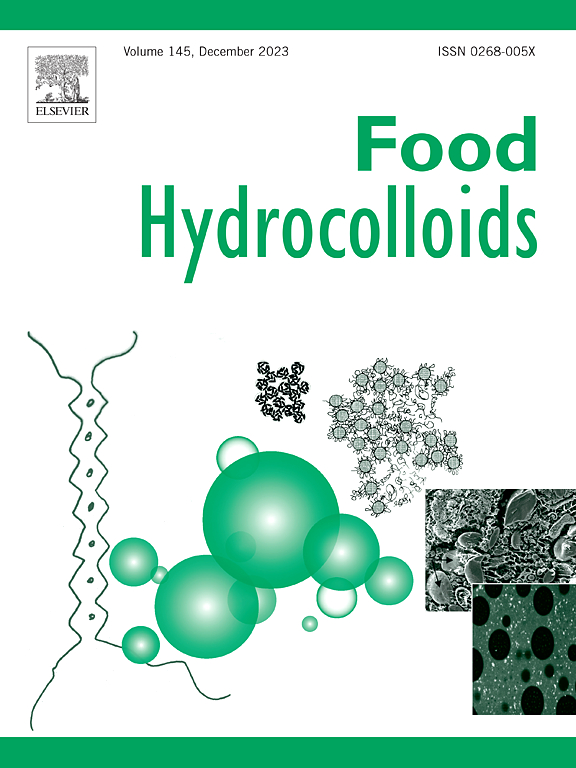压力诱导β-乳球蛋白/ c -藻蓝蛋白/淀粉复合凝胶的结构和功能特性
IF 11
1区 农林科学
Q1 CHEMISTRY, APPLIED
引用次数: 0
摘要
高压处理(HPP)已成为食品处理的关键可持续绿色替代方案,有效地保留了食品的感官和营养特性。本研究探讨了HPP在淀粉和生物活性蓝蛋白c -藻青蛋白(C-PC)存在下,产生β-乳球蛋白(BLG)凝胶的潜力。不同组分的二元(BLG/C-PC和BLG/淀粉)和三元(BLG/C-PC/淀粉)体系在4500 bar的高压(HP)条件下进行。BLG、C-PC和淀粉浓度维持在180、10和5 g/L。可见吸收和CD光谱证明,hp诱导的水凝胶保留了C-PC的颜色,部分保存了二级和三级结构。在高q范围的SAXS数据显示,C-PC诱导了二元体系凝胶中BLG的展开。相比之下,三元体系凝胶更好地保持了BLG的三级结构。SAXS(低q范围)和SEM分析表明,C-PC和淀粉通过增加孔隙大小来影响BLG hp诱导凝胶的纳米和微观结构。孔径的增加进一步影响了凝胶的流变行为和结构。C-PC增强了hp诱导凝胶的蛋白质溶解度和抗氧化活性,可能提高了开发的凝胶的生物活性和营养价值。本文章由计算机程序翻译,如有差异,请以英文原文为准。

Structural and functional characteristics of β-lactoglobulin/C-phycocyanin/starch composite gels induced by pressure
High-pressure processing (HPP) has emerged as a key sustainable green alternative for food treatment, effectively preserving food's sensory and nutritional properties. This study investigated the potential of HPP to develop β-lactoglobulin (BLG) gels in the presence of starch and the bioactive blue protein C-phycocyanin (C-PC). Various compositions of binary (BLG/C-PC and BLG/starch) and ternary (BLG/C-PC/starch) systems were subjected to high-pressure (HP) conditions at 4500 bar. BLG, C-PC, and starch concentrations were maintained at 180, 10, and 5 g/L. HP-induced hydrogels preserve C-PC colour and partial preservation of secondary and tertiary structures, as evidenced by visible absorption and CD spectroscopy. SAXS data at the high-Q range revealed that C-PC induces the unfolding of BLG within binary system gels. In contrast, the ternary system gel maintained the BLG tertiary structure better. C-PC and starch affected the nano and microstructures of BLG HP-induced gels by increasing the pore size, as demonstrated by SAXS (at low Q-range) and SEM analysis. This increase in pore size further influenced the resulting gels' rheological behaviour and texture profile. C-PC enhanced the protein solubility and antioxidant activity of the HP-induced gels, potentially boosting the bioactive and nutritional value of the developed gels.
求助全文
通过发布文献求助,成功后即可免费获取论文全文。
去求助
来源期刊

Food Hydrocolloids
工程技术-食品科技
CiteScore
19.90
自引率
14.00%
发文量
871
审稿时长
37 days
期刊介绍:
Food Hydrocolloids publishes original and innovative research focused on the characterization, functional properties, and applications of hydrocolloid materials used in food products. These hydrocolloids, defined as polysaccharides and proteins of commercial importance, are added to control aspects such as texture, stability, rheology, and sensory properties. The research's primary emphasis should be on the hydrocolloids themselves, with thorough descriptions of their source, nature, and physicochemical characteristics. Manuscripts are expected to clearly outline specific aims and objectives, include a fundamental discussion of research findings at the molecular level, and address the significance of the results. Studies on hydrocolloids in complex formulations should concentrate on their overall properties and mechanisms of action, while simple formulation development studies may not be considered for publication.
The main areas of interest are:
-Chemical and physicochemical characterisation
Thermal properties including glass transitions and conformational changes-
Rheological properties including viscosity, viscoelastic properties and gelation behaviour-
The influence on organoleptic properties-
Interfacial properties including stabilisation of dispersions, emulsions and foams-
Film forming properties with application to edible films and active packaging-
Encapsulation and controlled release of active compounds-
The influence on health including their role as dietary fibre-
Manipulation of hydrocolloid structure and functionality through chemical, biochemical and physical processes-
New hydrocolloids and hydrocolloid sources of commercial potential.
The Journal also publishes Review articles that provide an overview of the latest developments in topics of specific interest to researchers in this field of activity.
 求助内容:
求助内容: 应助结果提醒方式:
应助结果提醒方式:


